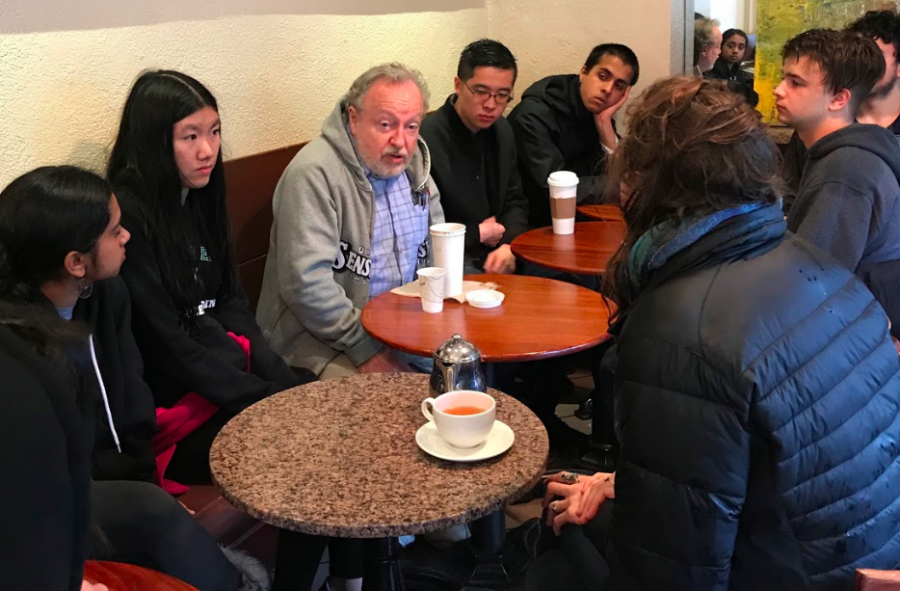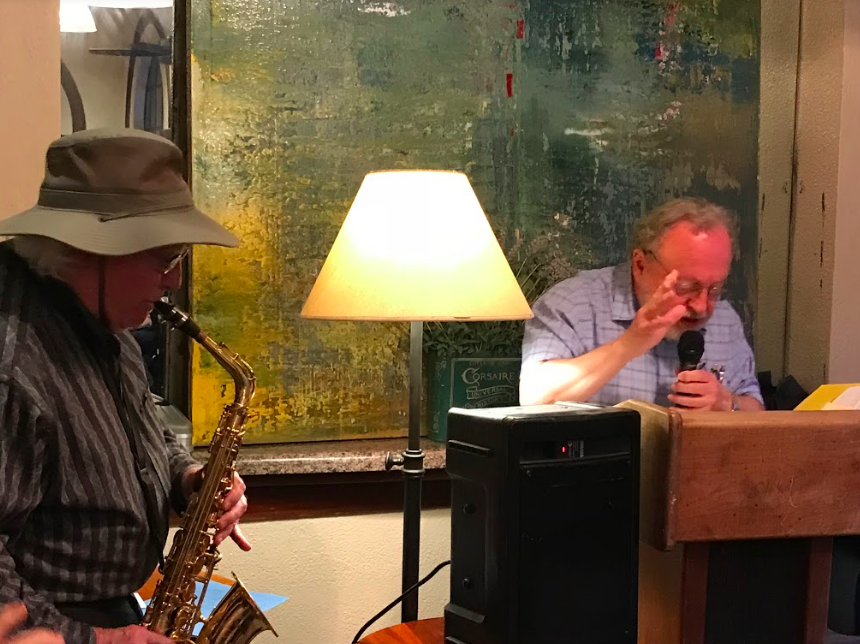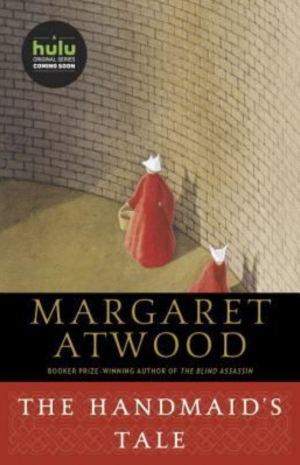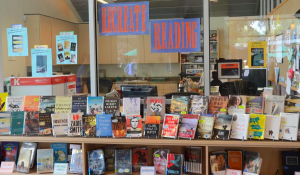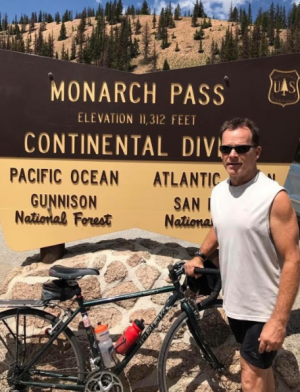Students experience Beat poetry reading
Provided by Charles Shuttleworth
Students talk to Gerald Nicosia, biographer of Jack Kerouac and beat poet. The beat generation, a group of poets that wrote after the second world war, greatly influenced political ideals at the time.
April 27, 2018
The students of English teacher Charles Shuttleworth’s senior elective, Jack Kerouac and the Beat Generation, and English teacher Jennifer Siraganian’s creative writing class, Theory and Practice of Poetry and Fiction, recently explored Beat poetry firsthand when they went on a day trip to San Francisco for “The Last Beat Poetry Reading” and other activities on March 15.
The Beat generation, a group of poets writing after the second world war, challenged social and political conformity with poems of revolutionary style and subject matter. Poet Jack Kerouac was arguably one of the most central figures to Beat poetry, helping to promote social change and personal freedom.
“So much of Beat poetry was centered in San Francisco and the Bay Area,” Shuttleworth said. “It’s just one of the real and exciting aspects of the course —that we are close to so much of the history of the Beat generation. It had such an important effect on American culture. To be able to explore it is great, but to explore it here is even better— really special.”
Students arrived at the Depot Bookstore and Cafe at 7:00 p.m. to hear Beat poet Gerald Nicosia, biographer of Jack Kerouac and the organizer of the poetry reading, start “The Last Beat Poetry Reading” by performing some of his own works.
The Beat poets read their poems while musicians played guitars and saxophones.
“With no rehearsal, the musicians simply play behind them and decide how to add riffs and frills,” Shuttleworth said. “It was basically following the beat tradition of spontaneous composition, an interaction between poets and musicians. It really added a wonderful element, [bringing] out the musicality of the poetry, the rhythms.”
The Beat poets were around 70 to 80 years old, as they were from the Beat Era or personally knew Jack Kerouac.
“It was a fantastic opportunity for students to see poets in action, to see the vibrancy of these old poets,” Shuttleworth said. “Reading new material, still vibrant and very much alive.”
Beat poet Clark Coolidge’s wife presented each person with a complementary copy of Now It’s Jazz – Writings About Kerouac, Coolidge’s book about Kerouac, as the students left the Depot Bookstore and Cafe at 8:30 p.m.
“[The Depot Bookstore and Cafe] was the bus depot. When Kerouac arrived in Mill Valley, that’s where he first got off the bus,” Shuttleworth said. “It’s supposedly about to close to become an Italian restaurant. [The reading] was called the Last Beat Poetry Reading because it may be the last reading that occurs at this venue, which has been a longstanding place for artistic poetry reading.”
Earlier in the day, students explored other places of historical significance to Beat poetry.
In the late morning, the students toured the City Lights Bookshop, the first all-paperback bookshop in America and the first to publish the works of the Beat poets. They also visited the Beat Museum across the street from the bookshop and explored the surrounding North Beach neighborhood.
The students visited a particular house in Mill Valley of Marin County, which was the setting of the second half of the book Dharma Bums by Jack Kerouac, a book they are currently studying in Mr. Shuttleworth’s class.


















![“[Building nerf blasters] became this outlet of creativity for me that hasn't been matched by anything else. The process [of] making a build complete to your desire is such a painstakingly difficult process, but I've had to learn from [the skills needed from] soldering to proper painting. There's so many different options for everything, if you think about it, it exists. The best part is [that] if it doesn't exist, you can build it yourself," Ishaan Parate said.](https://harkeraquila.com/wp-content/uploads/2022/08/DSC_8149-900x604.jpg)




![“When I came into high school, I was ready to be a follower. But DECA was a game changer for me. It helped me overcome my fear of public speaking, and it's played such a major role in who I've become today. To be able to successfully lead a chapter of 150 students, an officer team and be one of the upperclassmen I once really admired is something I'm [really] proud of,” Anvitha Tummala ('21) said.](https://harkeraquila.com/wp-content/uploads/2021/07/Screen-Shot-2021-07-25-at-9.50.05-AM-900x594.png)







![“I think getting up in the morning and having a sense of purpose [is exciting]. I think without a certain amount of drive, life is kind of obsolete and mundane, and I think having that every single day is what makes each day unique and kind of makes life exciting,” Neymika Jain (12) said.](https://harkeraquila.com/wp-content/uploads/2017/06/Screen-Shot-2017-06-03-at-4.54.16-PM.png)








![“My slogan is ‘slow feet, don’t eat, and I’m hungry.’ You need to run fast to get where you are–you aren't going to get those championships if you aren't fast,” Angel Cervantes (12) said. “I want to do well in school on my tests and in track and win championships for my team. I live by that, [and] I can do that anywhere: in the classroom or on the field.”](https://harkeraquila.com/wp-content/uploads/2018/06/DSC5146-900x601.jpg)
![“[Volleyball has] taught me how to fall correctly, and another thing it taught is that you don’t have to be the best at something to be good at it. If you just hit the ball in a smart way, then it still scores points and you’re good at it. You could be a background player and still make a much bigger impact on the team than you would think,” Anya Gert (’20) said.](https://harkeraquila.com/wp-content/uploads/2020/06/AnnaGert_JinTuan_HoHPhotoEdited-600x900.jpeg)

![“I'm not nearly there yet, but [my confidence has] definitely been getting better since I was pretty shy and timid coming into Harker my freshman year. I know that there's a lot of people that are really confident in what they do, and I really admire them. Everyone's so driven and that has really pushed me to kind of try to find my own place in high school and be more confident,” Alyssa Huang (’20) said.](https://harkeraquila.com/wp-content/uploads/2020/06/AlyssaHuang_EmilyChen_HoHPhoto-900x749.jpeg)



